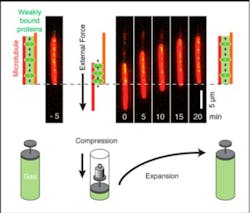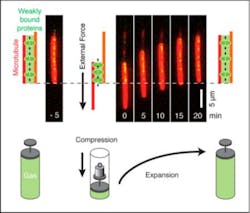Optical tweezers help understand important cell biology component
The mechanical basis of mitosis (cell division) is an important component in cell biology, but has only been understood in fragments so far. But scientists at the Dresden University of Technology (TU Dresden; Germany) and colleagues, using optical tweezers, have now been able to add another piece to the puzzle of cell mechanisms.
Related: Laser microscopy helps track key component of cell division
When cells divide, their genetic information is passed on to both daughter cells in a highly complex process. Therefore, an important role is played by small, cylindrical protein tubes called microtubules. They form the scaffold of the spindle apparatus, helping to distribute the genome in the chromosomes to the two daughter cells when cells divide. Besides their mission of docking onto the chromosomes directly and pulling them apart, microtubules are also of great importance for stabilizing the spindle apparatus. To this end, the microtubules overlap at the center of the cell, connecting the opposite spindle poles. When cells divide, it can be observed that these overlapping microtubules are initially made to slide in relation to one another by so-called motor proteins, but then stop before actually separating. Until now, scientists have only been able to explain the mechanism that inhibits their movement and stops the sliding in parts.
In cooperation with scientists from Wageningen University and the FOM Institute AMOLF (both in The Netherlands), the TU Dresden scientists, led by Professor Dr. Stefan Diez of the Center for Molecular Bioengineering, has now been able to show that a well-known principle of physics is also relevant in biology: Weakly binding proteins that preferably accumulate between overlapping microtubules behave like diffusing gas particles in a closed container. Those gas particles respond with rising pressure to a reduction in volume. This simple principle, as familiar from the ideal gas law as it is from common household bicycle pumps, is also how the weakly binding proteins create an ever-growing counter-pressure between the overlapping microtubules as they slide apart. This causes the movement to decelerate and stops the sliding. This biomolecular mechanism corresponds to the principle of a gas spring.
The scientists have been able to demonstrate this mechanism in experiment and theory. They have also managed to directly measure the resulting forces by means of optical tweezers. And they have finally been able to show that the gas-like pressure of the weakly binding proteins is strong enough to compensate the power of the motor proteins and keep the overlapping microtubules from falling apart.
This not only means that a minimal mechanism for stabilizing overlapping microtubules has been found and experimentally proven, but also that a further generally applicable mechanism has been added to the repertoire of cell biological mechanisms of action.
Full details of the work appear in the journal Cell; for more information, please visit http://dx.doi.org/10.1016/j.cell.2015.01.051.
-----
Follow us on Twitter, 'like' us on Facebook, connect with us on Google+, and join our group on LinkedIn

